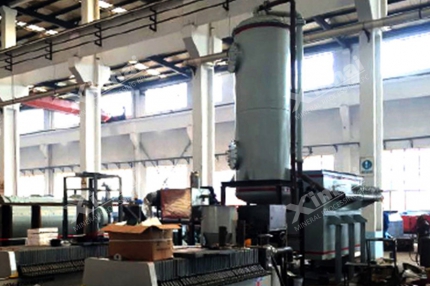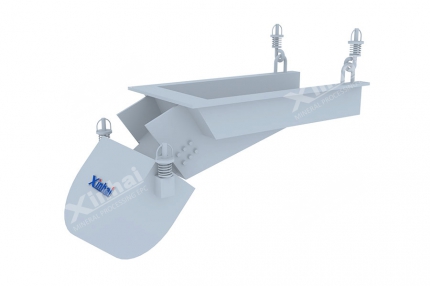According to the type of deposit, feldspar can be divided into pegmatite-type feldspar, white granite-type feldspar, granite-type feldspar, and feldspar placer, etc. Due to the different types of ore deposits and ore properties, the mining process of each feldspar is also different.

Use the table of contents below to navigate through the guide:
01Pegmatite Type Feldspar Mining Process
Generally, the pegmatite-type feldspar is of good quality and simple in mineral composition, so the beneficiation process is relatively simple. The beneficiation process includes sorting, crushing, grinding, and strong magnetic separation stages.
Sorting Stage: manual or color sorting to separate large gangue minerals;
Crushing Stage: coarse crushing and crushing;
Grinding Stage: use a gravel mill or rod mill lined with ceramic liner and quartzite for continuous grinding operation;
Strong Magnetic Separation Stage: strong magnetic separation is used to remove magnetic minerals such as iron and other magnetic minerals, and the magnetic field strength is generally above 1200kA/m.

02White Granite Type Feldspar Mining Process
The white granite type feldspar is uniform in mineralization and stable in quality, among which potassium feldspar and albite account for about 50-60%, and gangue minerals mainly include quartz, mica and iron-bearing minerals. Usually, this kind of deposit needs to be processed by flotation method to obtain feldspar concentrate. Its beneficiation process mainly includes:
Crushing Stage: the raw ore is crushed to about 20mm by coarse crushing (jaw crusher) and medium crushing (cone crusher);
Grinding and Classification Stage: the crushed products after mixing are ground to - 20 mesh in the closed-circuit circulation operation composed of rod mill and trammel. Then the - 200 mesh fine clay impurities are removed by cyclone and spiral classifier, and the materials between- 20 mesh to + 200 mesh are sent to flotation stage.
Flotation Stage: remove impurities such as mica, iron minerals and quartz. In the first stage, mica is obtained by flotation with cationic collectors (mainly amine collectors) in a weakly acidic medium. Mica is purified by flotation and wet screened with 80 mesh screen. Wet mica with more than 80 mesh is sold to mica processing factory; in the second stage, anionic collector (mainly sulfonated oil) is used to remove iron-bearing ore in a weakly acidic medium; in the third stage, a combined collector is used to separate feldspar and quartz in a weakly acidic medium.
Of course, the flotation operation is properly adjusted according to the mineral composition. If the mica content in the grinding product is very small, the first stage flotation can be skipped and the second stage iron removal flotation can be directly entered; if the iron and quartz content of the grinding products can meet the requirements of some glass factories after the first and second stages of flotation operation, the flotation separation of feldspar and quartz in the third stage can be omitted, and the products can be directly used as glass ingredients in the form of a mixture of feldspar and silica sand.

03Granite Type Feldspar Mining Process
Granite type feldspar is a kind of coarse-grained acidic plutonic igneous rock. Its embedded particle size is finer than that of pegmatite. The content of quartz accounts for about 25-30%, and mica and iron-bearing minerals account for about 10%. Feldspar is its main component (alkaline), that is, a crystalline feldspar composed of potassium feldspar and albite in a certain proportion.
Because the embedded particle size of granite is fine, the cost of grinding and processing is high. The beneficiation process of granite type feldspar is roughly the same as that of white granite. The beneficiation process includes crushing, grinding, classification, flotation (iron and mica removal) and flotation (quartz and feldspar separation) stages.
The flotation stage should be determined according to the mineral composition of grinding products. If the content of mica and iron is low, the flotation separation of quartz and feldspar will be carried out directly after classification and desliming. If the content of impurities such as mica and iron is high, it is necessary to remove the impurities such as iron and mica by flotation before the flotation separation of feldspar and quartz.

04Feldspar Placer Mining Process
Feldspar placer is mainly composed of quartz and feldspar, which is mainly formed by the accumulation of some granites and feldspar-bearing metamorphic rocks in the process of long-term weathering. The quality of feldspar placer is not as good as pegmatite feldspar deposit. But because of the omission of crushing and grinding operations in the mining and beneficiation process, the beneficiation cost is relatively low, and it is one of the important sources of feldspar concentrate at present.
The beneficiation process of feldspar placer is relatively simple. The beneficiation process mainly includes ore washing, scrubbing, classification, magnetic separation, flotation, etc.; subsequent separation operations need to be determined according to the mineral composition of classification products.

To Wrap Up
The above are the complete guide of feldspar mining processes. If you have other questions, or want to customize your feldspar mining plant, please leave your message or contact online service. We will give you feedback as soon as possible.


 marketing@ytxinhai.com
marketing@ytxinhai.com  0086 13810327080
0086 13810327080 






































































































 CHAT
CHAT MESSAGE
MESSAGE







